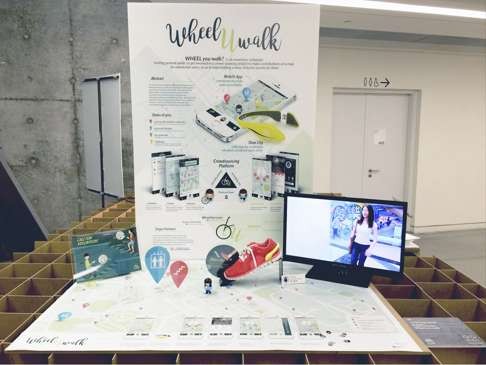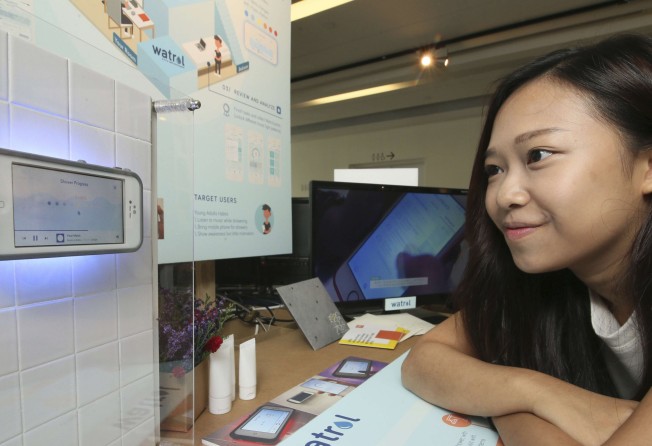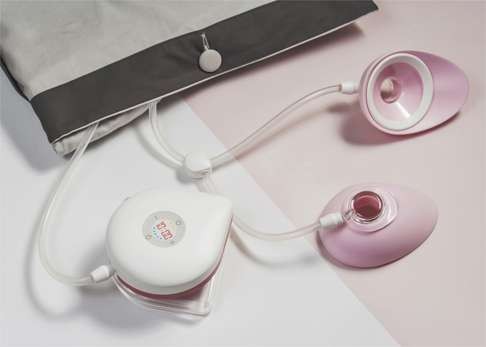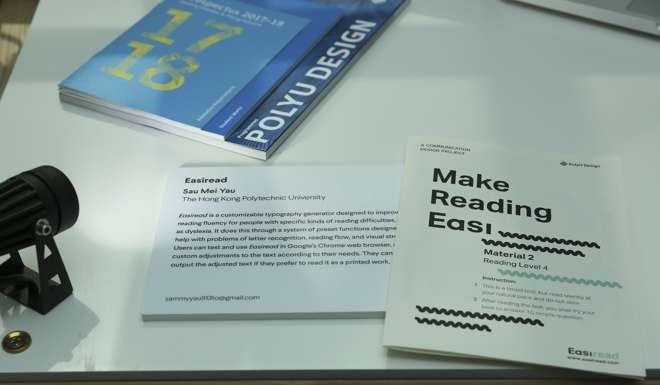
Hong Kong design graduates show life-improving tech at global student fair
Devices to help dyslexics read fluently, mothers to pump breast milk elegantly, isolated old people to play social games and all of us to use less water in the shower feature at Dubai Design Week

From a low-cost, Braille-friendly smartphone cover for the blind, to a raincoat that transforms into a sleeping bag or tent for refugees, Dubai Design Week’s exhibition of young graduates’ projects offers hope that a new generation of designers is more concerned with improving quality of life than simply churning out yet another iteration of the modern chair.
“It is good to feel that you are working towards some kind of progress as a young designer, as opposed to maintenance of an existing system. That is not inspiring to a young designer,” says the exhibition’s curator, Brendan McGetrick.
Touted as the largest student gathering ever assembled, the exhibition, held in October at Dubai’s new d3 design district, comprised 145 projects drawn from 50 universities in 30 countries and regions, a threefold increase from last year.
Projects were arranged according to three themes: designs that empower by offering new ways to expand capabilities; designs that connect through encouraging exchange and building communities; and designs that sustain through reducing waste and generating energy.
“If you look at enough projects, themes naturally emerge,” McGetrick says. “These are the issues of their day.”
One hot issue is the challenges facing old people and those who are disabled.

Inspired by her wheelchair-bound mother’s difficulties in getting around the city, the young designer came up with the idea of creating a digital accessory, clipped onto volunteers’ shoes, that vibrates when it senses stairs or other obstacles, reminding the user to find a wheelchair-friendly alternative. This new route can be fed back into the mobile application. When wheelchair users benefit, they can send a mobile thank you to the volunteer.
“It takes a lot of time to find accessible pathways and if you are not familiar with a place it can be difficult,” the designer says.
Elliot Mackie, a graduate of Australia’s Royal Melbourne Institute of Technology, was behind a project called Age Gets Better With Tools, which relies on bone data (collected using an infrared light scanner) and modelling software to create a customised tool handle.
Although Mackie graduated only this year, his project has already caught the eye of the Murdoch Children’s Research Institute in Melbourne. “The research began with looking at an ageing workforce and questioned why objects are designed for middle-aged white men. I wanted to design something for each and every individual,” he says.

“I found out from my research that no two dyslexics have exactly the same problem, so it is important to be able to customise according to your needs, like cleaning up excessive styling or helping identify letters. It is also easy to adjust spacing or font size or use a tracker mode to avoid skipping lines,” she says.
Matthew Sanders from the Rhode Island School of Design in the United States has created Social Gaming for the Elderly, a gaming platform designed to help homebound old people socialise by using a simplified console, built-in camera and menu screens navigated by voice or remote control. The system includes popular games such as Scrabble, bridge and poker.
The well-documented challenges of mothers who want to breastfeed while at work inspired Polytechnic University’s Wong Sin-bing to design her Devoted breast-pumping device, which comes with an elegant cape with side openings and a storage pocket; Ray Fontaine, a graduate of the Pratt Institute in Brooklyn, New York, has created an interchangeable decorative ear-cuff accessory called HearCuffs, designed to turn hearing aids into fashion statements.
“I asked myself why a hearing aid couldn’t be like eyewear, where you can buy so many different designs. I have created a universal piece that snaps onto the hearing aid and then you add a customisable design,” Fontaine says.
“I like the idea of the potential for different designers, from Tiffany to Etsy. We need to close the gap between design and medical devices.”

Many of the design projects focused on environmental sustainability, including Watrol, designed by Polytechnic University’s Sharon Li Pui-yee, to encourage people to gradually reduce their water usage during shower time by using goal setting and sensory feedback. This is done by way of music and LED light patterns that change over time to provide an easy-to-understand indication of the time spent in the shower.
Keyphone, by University of the Arts Bremen graduate Henning Marxen, is concerned with improving access for the blind. A touch screen shell sports 16 electrically conductive buttons that pass an electrical charge from the screen to the user’s hand, allowing for Braille inputs. Unlike existing bulky concepts, Marxen’s design is low-cost and offers other functions, including GPS guidance with voice output.
For some youngsters, a well-designed graduate project can jump-start a career. Royal College of Art graduate Malav Sanghavi’s Creaoto, for instance, has already received funding and has a patent pending. The form-changing, programmable smart socket for amputees allows users to customise for a comfortable fit through digital input. Different settings can be saved on a smartphone to adjust comfort to suit different activities, from walking or sitting.
A team of designers from the National University of Singapore has generated funding on Kickstarter to produce LEVIT8, a low-cost, origami-inspired, flat-folding portable device that transforms any table into a standing desk. Designed to break the unhealthy routine of sedentary work lives, it has no parts and requires no assembly.
The highlight of the exhibition was the Wearable Shelter, designed by Gabriella Geagea and Anne-Sophie Geay from Britain’s Royal College of Art. The garment has three functions, easily converting from a raincoat jacket with large pockets to a sleeping bag large enough for a parent and child or a four-person weatherproof tent when unzipped.
“The Global Grad Show really shows that design is fundamentally about the idea behind it and not just aesthetics. Creativity is something that is present everywhere and that allows us to open up contributions to design from anywhere,” the show’s curator said. “For me, the idea that design is about gadgets and aesthetics is a very flat understanding of something that is much more valuable and interesting.”